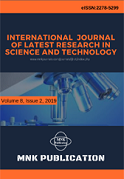DOI:10.29111/ijlrst ISRA Impact Factor:3.35, Peer-reviewed, Open-access Journal
Research Paper Open Access
International Journal of Latest Research in Science and Technology Vol.4 Issue 1, pp 4-6,Year 2015
Correspondence should be addressed to :
Received : 10 February 2015; Accepted : 20 February 2015 ; Published : 28 February 2015

| Download | 125 |
|---|---|
| View | 180 |
| Article No. | 10453 |
Light matter is typically composed of bright matter embedded in gray one as illuminated with an electron beam. New chemical data specific to two types of light matter is presented. The image of light matter demonstrated massive property of bright matter. The atomic percents (A%) of chemical elements measured for bright matter are 77.69 C, 3.42 O, 0.81 S, 15.31 Ta, and 2.77 Re. The weight percents (W%) are 21.74 C, 1.25 O, 0.62 S, 64.45 Ta, and 11.93 Re. The other data measured for the gray matter is 73.88 C, 3.47 O, 0.71 S, 16.94 Ta, and 5.0 Re in the A% and 17.88 C, 1.12 O, 0.43 S, 61.64 Ta, and 18.93 Re in the W%. The dominance of C and Ta in the A% is the same as the reported ones for single large light matter. The data revealed that bright and gray matter are much different in the atomic and weight compositions. The massive bright matter with higher C was matched to the proton as supported by the proton beams formed by laser light. The gray matter containing more Ta and Re was matched to the positron typically observed in laser light experiments. With this match, it is known that light matter is comprised of protons and positrons. Therefore, light matter is positive in charge as opposed to the negative electron. With this new finding, a new atomic model was proposed and it is composed of a nucleus, light-emitting structure (LES), and electron-occupying region (EOR), each represented by the proton and neutron, proton and positron, and electron, respectively. Here, the LES is a structure packed with both positrons and protons.
Copyright © 2015 Byungwhan Kim et al. This is an open access article distributed under the Creative Commons Attribution 4.0 International (CC BY 4.0) license which permits unrestricted use, distribution, and reproduction in any medium, provided the original work is properly cited.
Byungwhan Kim , " Positive Light Matter ", International Journal of Latest Research in Science and Technology . Vol. 4, Issue 1, pp 4-6 , 2015

MNK Publication was founded in 2012 to upholder revolutionary ideas that would advance the research and practice of business and management. Today, we comply with to advance fresh thinking in latest scientific fields where we think we can make a real difference and growth now also including medical and social care, education,management and engineering.

We offers several opportunities for partnership and tie-up with individual, corporate and organizational level. We are working on the open access platform. Editors, authors, readers, librarians and conference organizer can work together. We are giving open opportunities to all. Our team is always willing to work and collaborate to promote open access publication.

Our Journals provide one of the strongest International open access platform for research communities. Our conference proceeding services provide conference organizers a privileged platform for publishing extended conference papers as journal publications. It is deliberated to disseminate scientific research and to establish long term International collaborations and partnerships with academic communities and conference organizers.